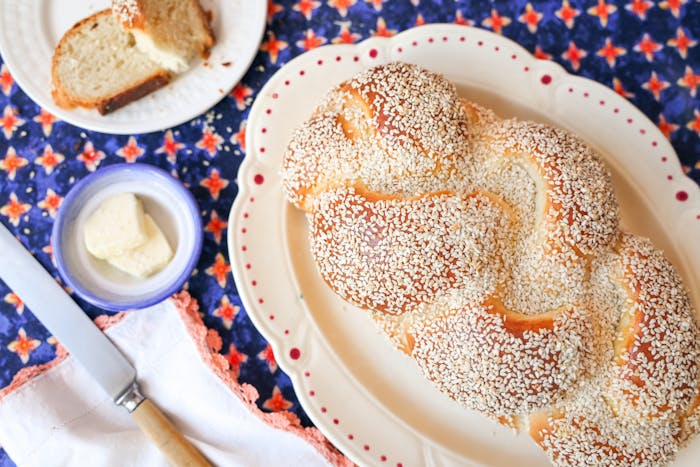Shared by Bonnie Stern and Anna Rupert


Cookbook author Bonnie Stern’s love of baking runs deep — it all started with her grandmother, Jenny Soltz, a mother of 11 and a challah-braiding legend. Money was tight, but Jenny had a secret weapon: her legendary round challahs. Every year, she entered them in the Grand Valley, Ontario county fair, and she always took home first prize: a winter’s supply of flour — just enough to keep those challahs, and her 11 children, going strong.
Jenny came from what was then the Austro-Hungarian Empire. Her family was well-off, so it's likely she didn’t cook or bake in those early years, Bonnie explains. But after immigrating to Canada — passing through the United States just before the turn of the century — she began recreating the foods that held meaning from home. She only spoke and understood Yiddish and couldn’t read or write, so her challah recipe likely lived in her hands, not on paper.
Her daughter Ruthie, Bonnie’s mother, never baked challah herself. In the Jewish neighborhoods of Toronto, fresh challah was easy to find at local bakeries, so she bought one every Friday for Shabbat dinner. And it wasn’t until Bonnie began preparing Friday night meals for her aging parents that she started baking challah.
Today, Bonnie typically makes a large loaf for the table and smaller ones for guests to take home — or for her husband and son, who can never resist sneaking a few bites before the meal. For Bonnie, no matter how big or elaborate the dinner might be, the challah is always the star. “Knowing that my grandmother made challah every week, and that her challah had such an important significance in the family, makes me feel more deeply about making challah every week for my family,” she says. Every loaf she bakes is a tribute to her grandmother’s legacy.
Bonnie and her daughter, Anna Rupert, shared their family challah tradition in the Grandmas Tent at The Great Nosh, a giant picnic we hosted in New York in June 2025.
Read more about Bonnie’s family in “Aunt Lil’s 100-Year-Old Meringue Rugelach, Courtesy of Bonnie Stern” and get her recipe for meringue rugelach. Plus, check out more recipes from The Great Nosh’s Grandmas Tent.
Place 5 ½ cups of flour in the bowl of your stand mixer. Add the salt, sugar, and yeast. Mix with the dough hook on low speed until combined, about 2 minutes.
In a separate bowl, whisk together the eggs, water, and oil until smooth.
With the mixer running on low, slowly pour the wet ingredients into the dry ingredients. Mix until a sticky dough forms for about 2 minutes.
Continue mixing on low speed, adding more flour about ¼ cup at a time, until the dough pulls away from the sides of the bowl but still sticks slightly to the bottom, about 2 minutes. Avoid adding too much flour – the dough should stay soft and slightly moist.
Increase mixer speed to medium-low and knead for 2-4 minutes, until the dough is smooth and elastic. Then turn the dough out onto a lightly floured surface and knead it by hand for about 1-2 minutes, adding just enough flour to keep it from sticking. The dough should stay soft and slightly tacky.
Lightly oil a large bowl. Place the dough into the bowl, turning it to coat all sides with oil. Cover the bowl with plastic wrap and a tea towel. Let rise in a warm place until almost doubled in size, about 1-2 hours.
After rising, gently punch down the dough to release air. Turn it out onto a lightly floured surface. To make two large challahs, divide the dough in half, then cut each half into 3 or 4 equal pieces and braid as desired. To make three regular-sized challahs, divide the dough into three pieces, then cut each piece into 3 or 4 equal pieces and braid as desired.
Place the braided dough on a parchment-lined baking sheet. Cover loosely with oiled plastic wrap and let rise for 30-60 minutes, until puffy and almost doubled.
Whisk an egg with a little water and a pinch of salt.
Preheat the oven to 350F. Gently brush the loaves with the egg wash. Sprinkle with seeds of choice or flaky salt. Bake for 25-30 minutes, checking after 20 minutes. If the tops brown too quickly, reduce oven temperature to 325F and tent the loaves loosely with foil. The bread is done when an instant-read thermometer inserted into the center reads 185–195F.
Transfer loaves to a wire rack to cool completely.
Leftover challah, stored in an airtight container at room temperature, is best eaten within 2-3 days.
Excerpted from “Don't Worry Just Cook: Delicious, Timeless Recipes for Comfort and Connection by Bonnie Stern and Anna Rupert” (Appetite by Random House). Copyright © 2022.